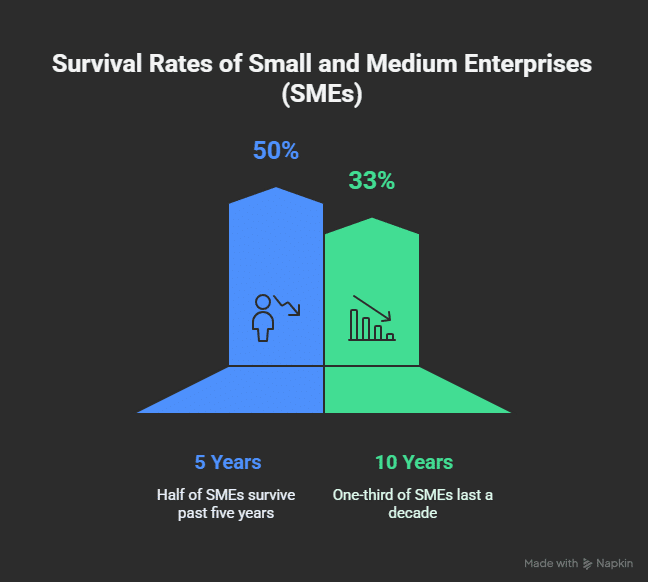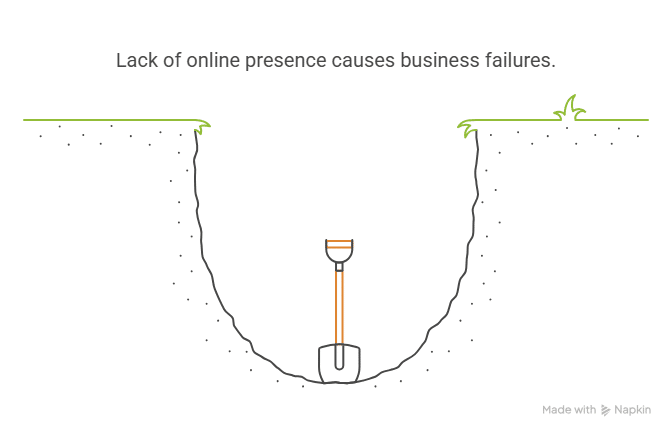Small and medium-sized enterprises, or SMEs, are the heartbeat of many economies.
They spark new ideas, put people to work, and keep communities humming along. But running one is not a walk in the park, and plenty of owners wonder how long their business might hold up.
So, what is the average lifespan of an SME?
Let’s explore the numbers, the reasons, and the real-world factors that shape this question.
How Long They Last?
An SME’s lifespan is just how many years it keeps going before shutting down, getting sold, or blending into something else. Research paints a mixed picture.
The U.S. Small Business Administration says only about fifty percent of small businesses survive to make it past five years. By the time 10 years roll around, only a third are still standing.

Around the world, the story is similar, though the details shift depending on where you look or what trade they are in. Generally, SMEs clock in between five and 10 years, but stats only tell part of the tale.
The Industry Angle
Different businesses, different fates. A tech outfit might flare up and fizzle out quickly, while a corner store handed down through the family could stick around forever.
Cafes and dining establishments often burn out fast, squeezed by tight profits and picky customers. On the other hand, factories or consulting gigs sometimes hang on longer, riding steady demand or a unique edge.
What an SME does day-to-day has a big say in its staying power.
Small Business Insurance Options
Risk comes with the territory, and SMEs face plenty, from legal fights to storms wrecking their setup. That is where small business insurance options step up.
Things like liability coverage, property protection, or plans for when work stops, can save a company from folding after a big hit. The right coverage can mean the difference between bouncing back and calling it quits.
The Economy’s Push and Pull
Big-picture money trends can lift SMEs up or knock them flat. Tough times like recessions or price spikes hit small players hardest, especially if cash is already tight. Back in 2008, the financial recession wiped out a lot of little firms.
But when the economy is humming, businesses get breathing room to grow and tweak their game. Stuff outside their control often calls the shots on who lasts.
Who’s in Charge
The folks running the show can make a substantial difference. Good leaders with a solid plan and a knack for adjusting can keep an SME kicking way past the norm.
Think of companies that went online when lockdowns hit. They outlasted the ones too stubborn to shift. Messy management, though, can tank even a hot startup in no time. It’s not just about starting strong; it’s about keeping things on track.
Money Troubles
Cash is king, and SMEs bleed out fast without it. Running dry is why a lot of them close up shop. Late payments, big bills, or surprise expenses can choke a business quickly.
The ones that nail their budgets, obtain loans when needed, or are able to keep a little extra money tend to tough it out. Cash flow’s not flashy, but it’s what keeps the doors open.
Change is Needed
Staying alive often boils down to bending with the times. Tech moves fast, customers switch tastes, and rules keep shifting. SMEs that pick up new tricks, tune into their crowd, or tweak what they sell to stay in the game. The ones that dig in their heels get left behind. Being flexible is not a bonus; it is a must.
And if you want to survive in digital age – you’ll need to think beyond the traditional marketing. In fact, starting with digital marketing would be good decision.
Digital Marketing Isn’t Just Strategy—It’s Survival
When you’re running a small business, there’s barely enough time to breathe — let alone market yourself. But without some kind of online presence, you’re just hoping people magically find you. That rarely works.
I’ve seen so many good businesses failing — not because they were bad at what they did, but because no one knew they existed.

That’s the part digital marketing solves.
You don’t need to be everywhere, but you do need to show up. Maybe that’s SEO. Maybe it’s Instagram. Maybe it’s a blog like this one. The point is: visibility gives you a shot at staying in the game.
And if you’re a blogger or content creator reading this? You’re already halfway there. You understand the value of showing up online better than most brick-and-mortar business owners do. Don’t underestimate that.
Blogging is a Small Business (Even if You Don’t Call It That)
I used to think blogging was just a side hustle or a creative outlet. It took me a while to realize it’s actually a business—and it needs to be treated like one if you want it to last.
You’re writing content, serving an audience, testing strategies, tracking growth… That’s what small businesses do.
But here’s the thing: blogging doesn’t usually die in a dramatic way. It fades. One skipped post turns into two. You stop checking your analytics. The passion you had at the start? It starts to feel like a chore. I’ve been there. Most bloggers have.
The ones who keep going? They adapt. They simplify. They find new reasons to care about their work.
If you’ve hit that wall, you’re not failing — you’re just overdue for a reset.
Here’s what helps me:
Revisit your why. Not the “make six figures” reason. The real one.
Tweak, don’t overhaul. A new format, a shorter post, a fresh layout—it can spark momentum.
Talk to your readers. They’ll remind you why this work matters.
No fancy words. No “content marketing strategy.” Just small actions, repeated often. That’s what keeps a blog breathing.
If You’re Still Reading, You’re Probably One of the Few Who’ll Make It
Most people quit before things get interesting. That’s not a knock—it’s just the truth.
If you’re still here, thinking deeply about how to make your business or blog last, you’re already doing what most won’t. That’s your edge.
You don’t need to go viral. You don’t need to be perfect. You just need to keep showing up, learning, adjusting, and staying honest with yourself.
And if no one’s said this to you lately: You’re doing better than you think.
In Conclusion
So, what’s the average lifespan of an SME? Five to 10 years is around the average, but it is not set in stone.
The trade, the economy, the bosses, the cash, and the ability to roll with it all play a part.
Some tank in months, others last lifetimes. With smart moves and a bit of grit, an SME can outrun the averages and carve its own path.









